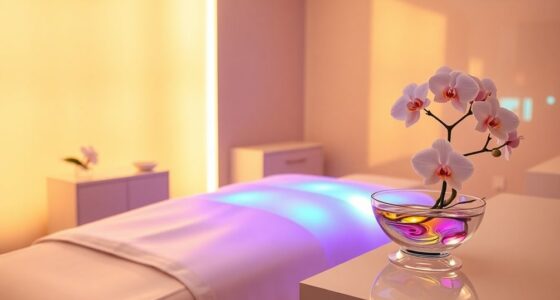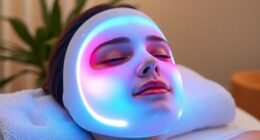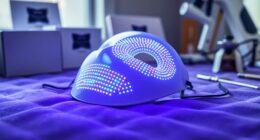You can see immediate improvements with LED therapy, like enhanced skin radiance and reduced redness. However, for optimal results, it usually takes around 8 to 16 sessions. In the short term, you might notice fewer breakouts and improved skin texture within weeks. Consistency is key, so aim for multiple sessions weekly, depending on your specific goals. Different individual factors, like skin type and overall health, can influence how quickly you see changes. If you're curious about maximizing your results and understanding the best practices, there's much more to explore on this topic.
Key Takeaways
- Immediate effects include radiant skin and reduced redness, often noticed right after treatment.
- Short-term results, such as reduced acne breakouts, typically appear within weeks.
- Cumulative benefits require 8-16 sessions for optimal improvement in skin conditions.
- Maintenance treatments are recommended monthly or every few months to sustain long-term results.
- Individual factors like skin type and health can significantly influence result timelines.
Immediate Effects of LED Therapy
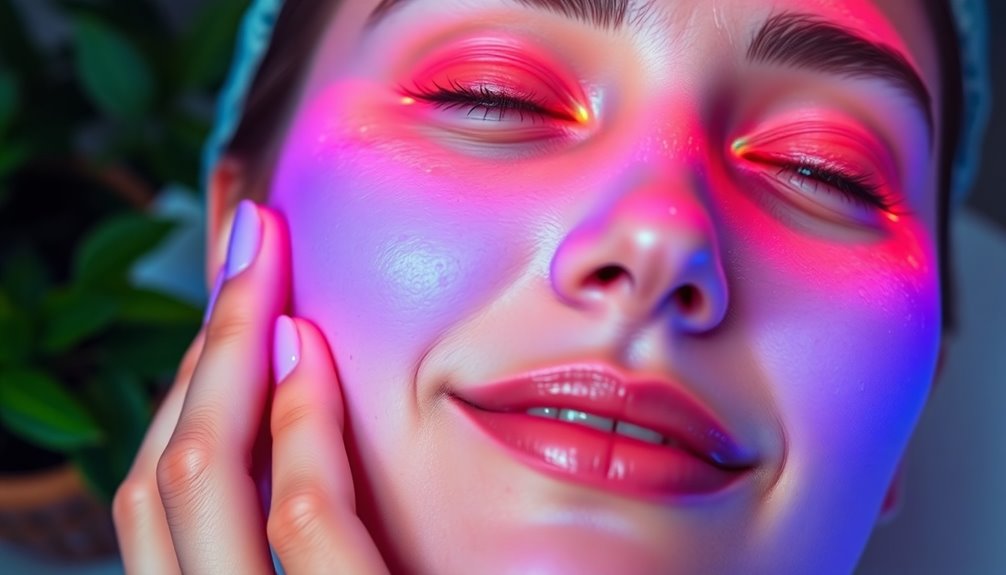
When you undergo LED therapy, you'll likely notice immediate effects that enhance your skin's appearance. Your skin may appear more radiant and hydrated right after treatment, giving you a beautiful glow. If you have irritated skin, you might see a reduction in redness almost instantly. Plus, if you struggle with acne, you'll likely notice calming effects on mild to severe breakouts. This therapy boosts cellular activity, increasing circulation and promoting healing. You could even experience mild pain relief thanks to endorphin release. Fine lines may look less pronounced, and scars can start to improve as well. With no downtime required, you can quickly return to your daily routine, feeling rejuvenated and refreshed. Additionally, this therapy is effective for improving circulation between blood and tissue cells, further enhancing your skin's overall health.
Short-Term Results Overview
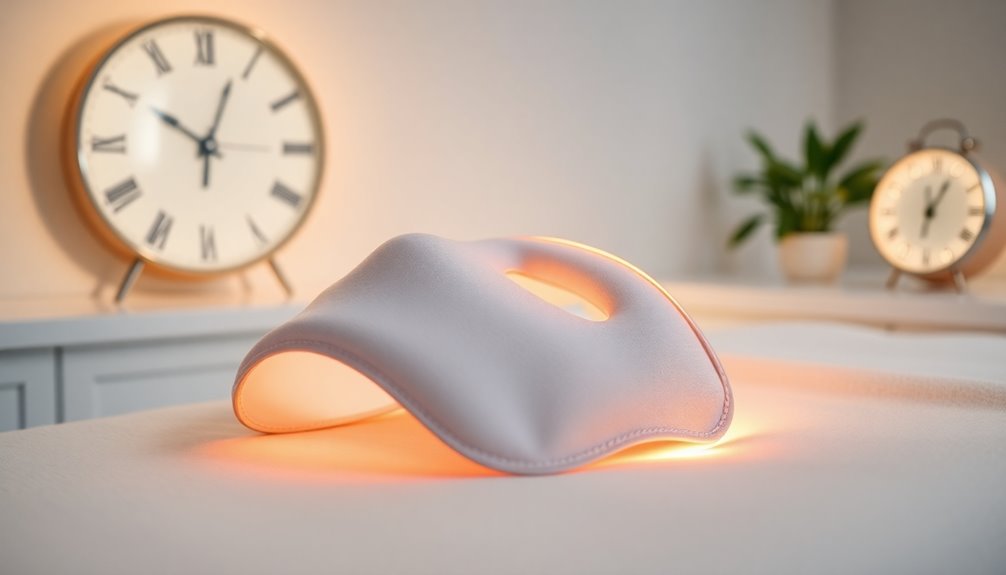
After experiencing the immediate effects of LED therapy, many individuals start to notice short-term results within just a few weeks. You might see a reduction in redness and inflammation almost immediately.
Improvements in acne can also become noticeable, with fewer active breakouts and smaller pimples. Your skin texture might improve, although changes can vary from person to person. Consistency is key; regular sessions are crucial for these noticeable improvements.
Additionally, you could feel enhancements in mood and energy levels within days. Keep in mind that individual responses can differ, and lifestyle factors like diet and sleep may influence how quickly you see results. Some mild side effects, such as headaches, may occur but are typically transient. It's important to remember that the severity of acne can influence how quickly you see results.
Long-Term Benefits Explained
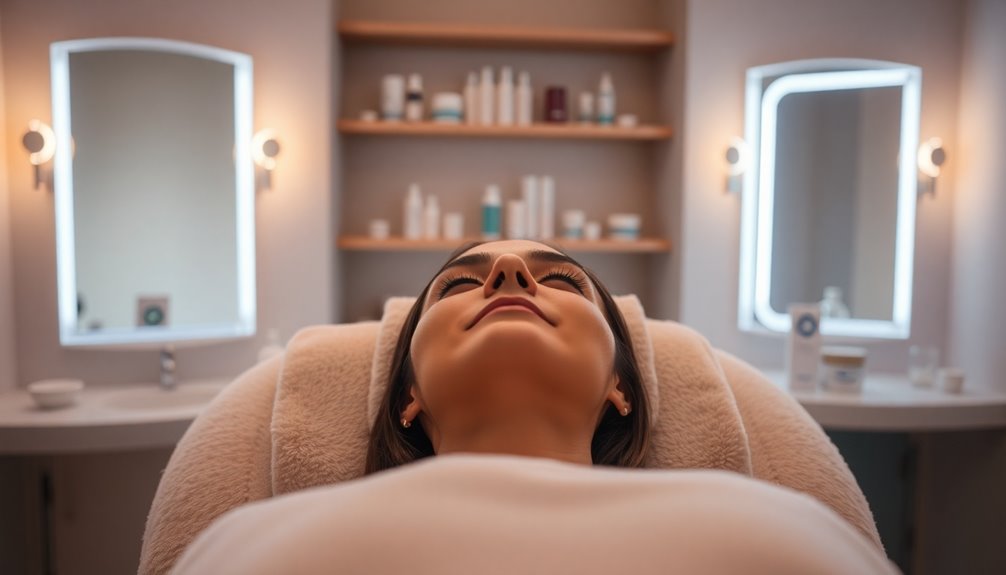
The transformative power of LED therapy unfolds over time, revealing a spectrum of long-term benefits that can enhance your skin's health. Typically, you'll need 8-16 sessions to experience cumulative results, with immediate improvements often visible after just one treatment. Regular visits help manage conditions like acne and psoriasis, while also promoting wound healing and reducing signs of aging. Red LED light stimulates collagen production, making your skin smoother and softer. Additionally, this therapy utilizes skin-safe, low-level light in various wavelengths, ensuring it is gentle on the skin.
For optimal results, maintenance treatments every month or few months are recommended. Combining LED therapy with other treatments like HydraFacial or chemical peels can further elevate its benefits, addressing multiple skin concerns effectively. Consistency is key to unlocking the full potential of LED therapy for lasting skin health.
Factors Affecting Results
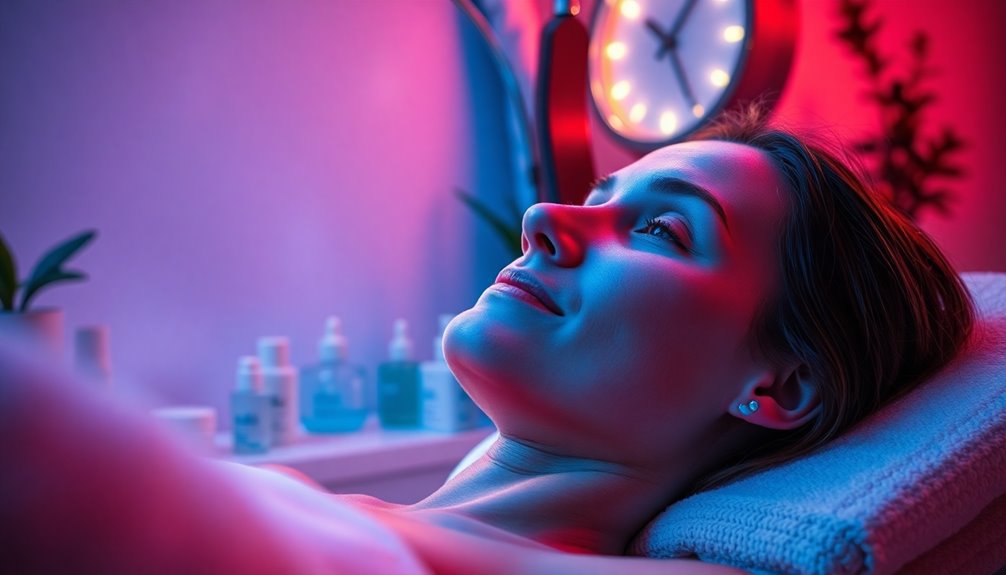
Several factors can influence how quickly you see results from LED therapy, making it crucial to understand your unique circumstances.
Your individual response plays a significant role; everyone's skin type, health status, and genetic factors can affect how your body reacts. Hormonal changes may also impact your skin's response. Additionally, cellular stimulation from LED therapy can vary based on how well your body responds to the treatment.
Additionally, treatment goals matter—more severe skin conditions might take longer to improve. Specific targets, like pain relief versus skin rejuvenation, can dictate the timeline as well.
Lastly, overall health, including diet, hydration, and stress levels, can either support or hinder your results. By considering these factors, you can better manage your expectations and optimize your LED therapy experience.
Recommended Session Frequency
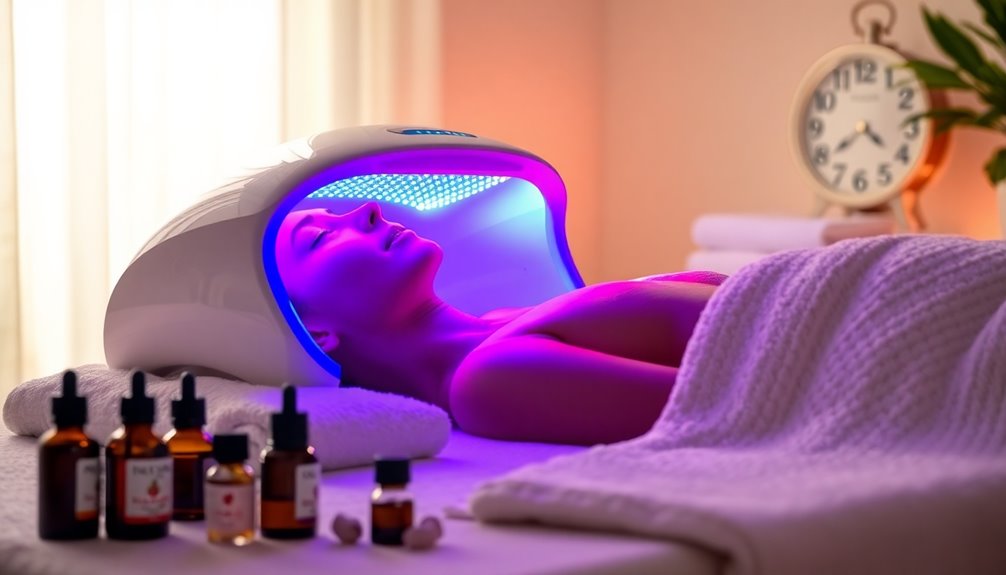
Understanding the right session frequency can significantly enhance your LED therapy results, tailored to your specific goals.
For skin rejuvenation, aim for 3-5 sessions a week, lasting 10-20 minutes each. Keep the intensity low to medium, positioning yourself 10-15 cm from the light source. Consistency is key for optimal results in skin rejuvenation.
If you're focusing on pain relief or wound healing, start with daily sessions, then reduce to 3-5 times a week, with each session lasting 20-30 minutes at medium to high intensity.
For hair growth, you should treat yourself every other day for 10-20 minutes with low to medium intensity.
Importance of Maintenance Treatments

While you may see impressive results from LED therapy initially, maintaining those results requires consistent follow-up treatments.
Regular maintenance is crucial to keep your skin looking its best, especially for chronic conditions like acne and rosacea. Ongoing sessions stimulate collagen production and help manage inflammation, ensuring your skin remains healthy and youthful. Additionally, this therapy promotes improved circulation, which further enhances skin health and appearance.
Skipping treatments can lead to a return of skin issues, so consistency is key. Typically, you'll want to schedule maintenance sessions every 1 to 4 weeks, depending on your specific needs.
Pairing these treatments with a solid skincare routine will enhance your results. Remember, your lifestyle factors, like diet and sleep, also play a role in how well LED therapy works for you.
Variability in Individual Results
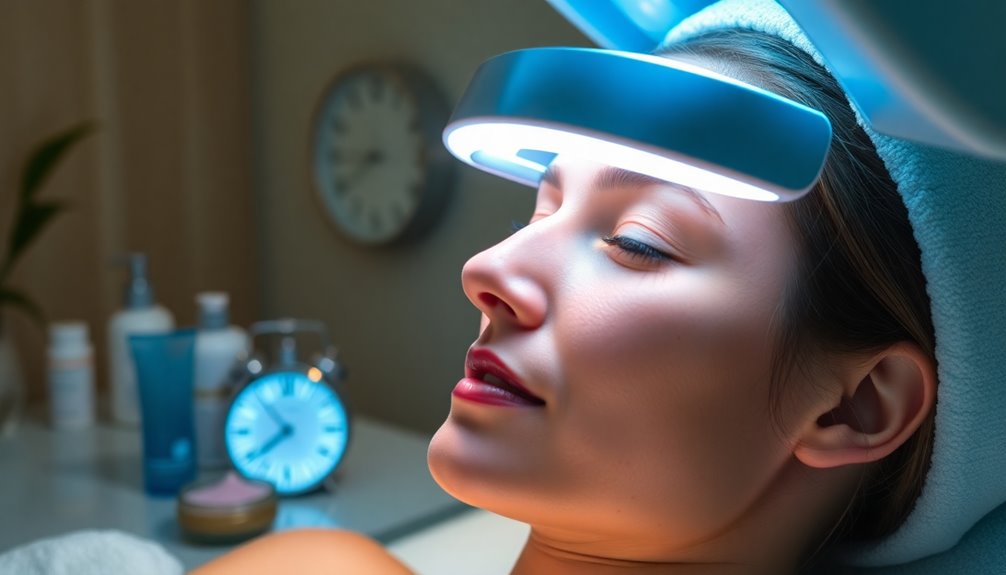
Consistency in maintenance treatments plays a significant role in achieving optimal results, but the effectiveness of LED therapy can still vary widely among individuals.
Factors like skin pigmentation and tissue density affect how your body absorbs light energy, leading to different responses. If you have darker skin, you might need higher doses to see results.
Your metabolic rate and any health conditions can also influence your response time—those with chronic issues may require adjustments to start seeing benefits. Additionally, optimal dosing is essential for ensuring that you receive the therapeutic outcomes expected from the treatment.
Age and genetics further complicate matters, as older individuals may need more intense light.
Ultimately, while some notice changes in days, others might take weeks or months, making regular sessions crucial for maximizing the therapy's effectiveness.
Frequently Asked Questions
Can LED Therapy Help With Specific Skin Conditions?
LED therapy can definitely help with specific skin conditions.
For acne, blue light targets bacteria and reduces inflammation.
If you're dealing with psoriasis, red and near-infrared light can lower redness and plaques.
Red light therapy is effective for anti-aging, stimulating collagen production to smooth fine lines.
Each treatment type offers unique benefits, so you can choose the one that fits your needs best.
Regular sessions are key to seeing sustained improvements.
Is LED Therapy Safe for All Skin Types?
Yes, LED therapy is safe for all skin types.
It's non-invasive and painless, meaning you won't experience physical harm or discomfort. You can resume daily activities right after treatment, as there's no downtime.
The therapy is customizable, allowing you to address specific skin concerns. Just remember to consult a professional to tailor the treatment to your skin's unique needs, especially if you have sensitive areas or specific conditions.
How Does LED Therapy Compare to Other Treatments?
When you compare LED therapy to other treatments, you'll find it's non-invasive and generally safe.
Unlike some methods that involve harsh chemicals or intense procedures, LED therapy uses light wavelengths to stimulate healing. You might notice quicker skin improvements without downtime. This non-invasive approach is suitable for all skin types and can address various concerns, including fine lines, wrinkles, and uneven complexion. By promoting collagen production and reducing inflammation, how LED therapy enhances antiaging becomes evident as users experience firmer, more radiant skin. Many individuals find that regular sessions lead to lasting results, making it a popular choice among those seeking a rejuvenated appearance without the risks associated with more aggressive treatments.
Plus, it can complement treatments like chemical peels or laser therapy, enhancing overall results.
Ultimately, it offers a gentle yet effective option for various skin concerns and pain relief.
Can I Use LED Therapy While Pregnant?
Yes, you can use LED therapy while pregnant, but it's essential to take precautions.
The therapy is non-invasive and doesn't emit harmful UV rays, making it generally safe. However, you should consult your healthcare provider to ensure it's appropriate for you.
Monitor how your body responds, avoid overheating, and choose reputable devices.
What Should I Expect During an LED Therapy Session?
During an LED therapy session, you can expect it to last between 10 to 30 minutes, depending on the device and treatment area.
You'll feel comfortable and relaxed, as the device emits light without direct contact with your skin.
After the session, you should avoid swimming and saunas for 12 hours, and use sunscreen afterward.
Conclusion
In conclusion, LED therapy can deliver noticeable results in as little as one session, but most people see significant improvements after about 4 to 6 weeks. Interestingly, studies show that over 80% of users report increased skin radiance and reduced signs of aging with regular treatments. To maximize these benefits, stay consistent with your sessions and don't forget maintenance treatments. With patience and commitment, you're sure to enjoy the transformative effects of LED therapy!




